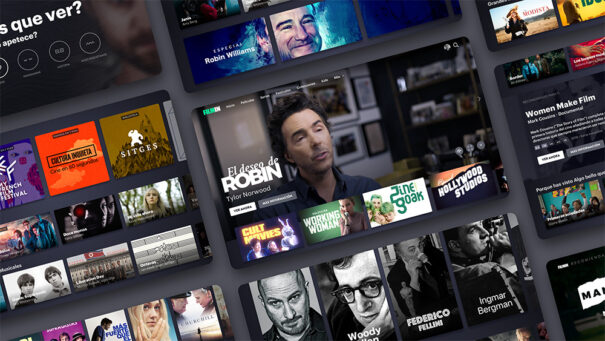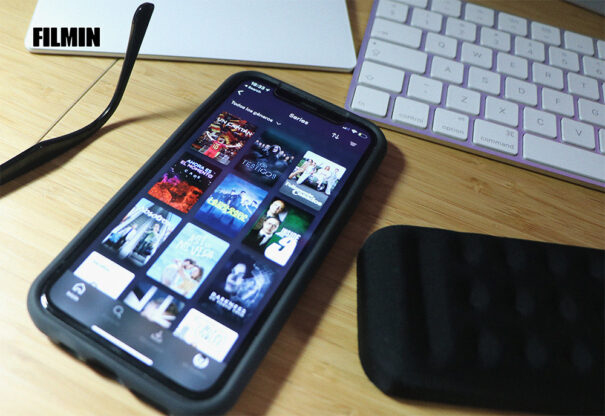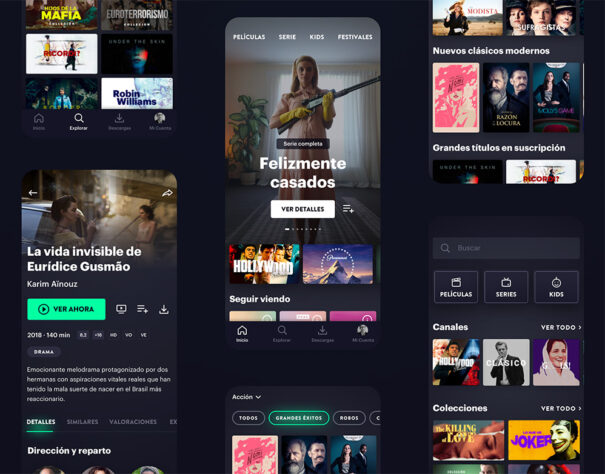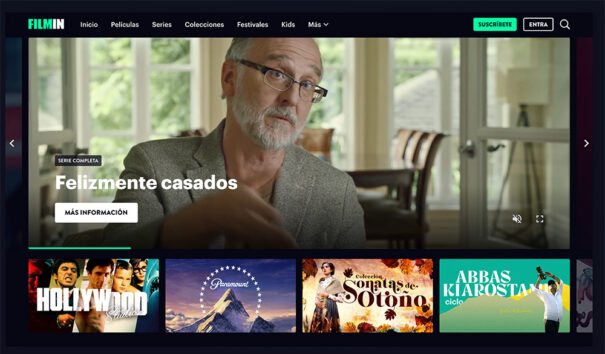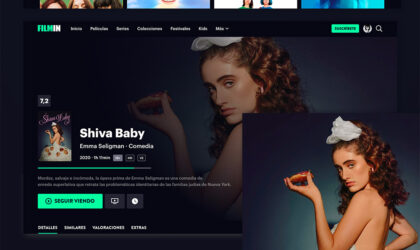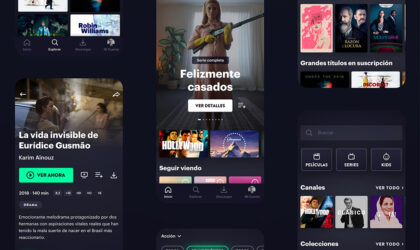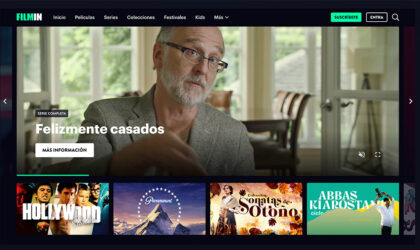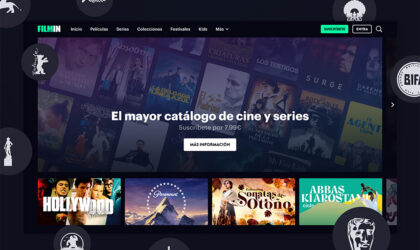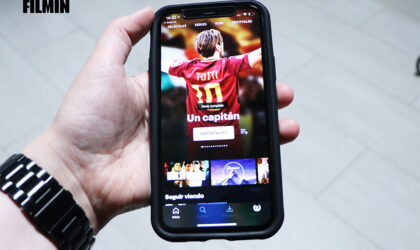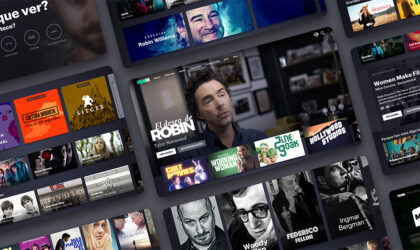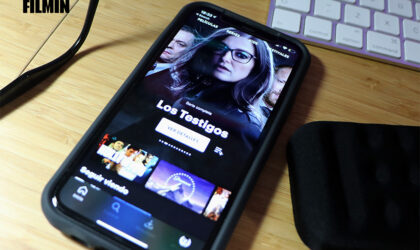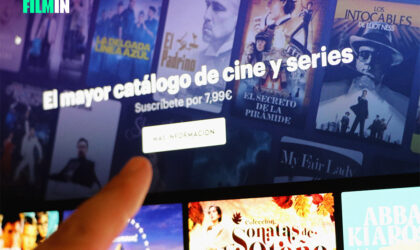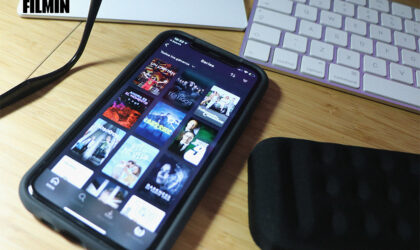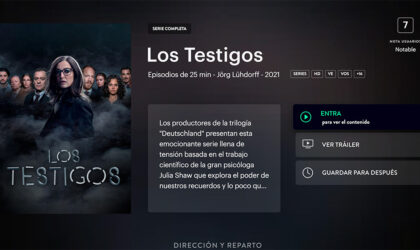Guía rápida para entender UI y UX: El caso de Filmin
UI (User Interface) y UX (User Experience) son dos términos clave en el mundo de las plataformas VOD. ¿Pero en qué consisten? ¿Cómo condicionan nuestra relación con las aplicaciones? ¿Cuál es son sus tendencias actuales?
 En esta entrevista, Julia Slipenchuk, Head of Product Design de of the movie, abre las puertas a este particular universo, al tiempo que comparte las claves de la UI y UX de la popular plataforma de vídeo bajo demanda.
En esta entrevista, Julia Slipenchuk, Head of Product Design de of the movie, abre las puertas a este particular universo, al tiempo que comparte las claves de la UI y UX de la popular plataforma de vídeo bajo demanda.
¿A qué nos referimos con UI / UX cuando hablamos de aplicación VOD?
Cuando enviamos un mensaje a nuestra madre o estamos mirando el Twitter, no queremos que nada nos distraiga de nuestro objetivo. En este momento, lo que queremos es saber cuándo nos espera mamá para la cena o compartir rápido esa foto desde Twitter a un amigo. En ese momento somos usuarios y estamos comunicando con la tecnología para que nos ayude a lograr nuestros objetivos a través de un producto digital como WhatsApp o Twitter. UI / UX está detrás y solo nos ayuda.
Concretamente el UX (User experience) se enfoca en entender profundamente al usuario. Es el proceso de la investigación de sus necesidades y valores, con el fin de conocer las habilidades y limitaciones de las personas. Las mejores prácticas de UX ayudan a mejorar la calidad de la interacción y la percepción del producto por parte del usuario. Por otro lado, UI (User Interface) es responsable de la apariencia estética de los elementos a través de los cuales una persona usa el producto. Son botones, iconos, tipografía, colores, etc. Además, ayuda a transmitir la personalidad, la marca del producto digital.
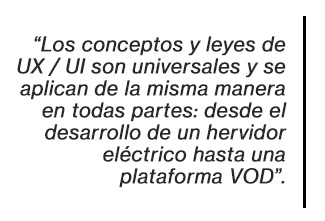 La esencia de toda la experiencia del usuario es la interacción. Se trata de una conversación entre un producto digital y el usuario. Si la conversación es aburrida o estresante, el usuario se irá y hablará con alguien más interesante. UX / UI intenta hacer esa conversación siempre más excitante. Los conceptos y leyes de UX / UI son universales y se aplican de la misma manera en todas partes: desde el desarrollo de un hervidor eléctrico hasta una plataforma VOD.
La esencia de toda la experiencia del usuario es la interacción. Se trata de una conversación entre un producto digital y el usuario. Si la conversación es aburrida o estresante, el usuario se irá y hablará con alguien más interesante. UX / UI intenta hacer esa conversación siempre más excitante. Los conceptos y leyes de UX / UI son universales y se aplican de la misma manera en todas partes: desde el desarrollo de un hervidor eléctrico hasta una plataforma VOD.
Por supuesto, en Filmin tenemos en cuenta las características del uso de nuestro producto. Por ejemplo, el hecho de que la gente nos mire en su sala de estar el sábado por la noche, lejos de la pantalla y con poca luz. Tenemos en cuenta la especificidad del producto y qué dispositivos utilizan las personas que consumen nuestra plataforma. Puede ser una tele, un laptop, una tablet, un móvil o un PC.
Tenemos un gran equipo editorial y un gran equipo de redes sociales; ellos y ellas ayudan a desarrollar un producto de una manera que refleje la profundidad del cine y lo que quieren nuestros usuarios. Mucha gente piensa que VOD son películas, series o, por ejemplo, documentales. Pero, en realidad, los usuarios no perciben el mundo de esa manera. Una plataforma VOD es también la actualidad, los procesos de la sociedad, las personas y, a veces, incluso el escapismo después de un día duro o simplemente el consuelo cuando tienes el corazón roto.
Todo afecta al usuario
¿Cuáles son las claves que hacen que una UX sea completamente satisfactoria?
La impresión de las personas sobre el uso del producto, es decir, UX, se ven influenciadas mucho más que el diseño en sí. Las personas se ven afectadas por la reputación de la empresa. Están influenciados por lo que otras personas dicen sobre la empresa o el producto. Las personas se ven afectadas por la apariencia de un producto y cómo se han sentido en el pasado con respecto a otras cosas similares. Las personas se ven afectadas por cómo se sienten en este día, si están abiertos a este nuevo producto en el momento en que lo usan. Las personas se ven afectadas por lo bien que pueden aprender a usar el producto, lo que pueden obtener de él, lo decepcionados que están con otros productos que no han cumplido su promesa. Todo afecta al usuario y todo eso son puntos claves para una UX satisfactoria.
¿De qué manera ha trabajado el área UI / UX Filmin desde los últimos años?
UI / UX es una iteración continua, un proceso de prueba constante de soluciones de diseño a lo largo del ciclo de vida del producto. El proceso de diseño de UX consiste en estudiar el comportamiento del usuario a través de la investigación y las pruebas para convertir ese conocimiento en estrategias que se pueden aplicar para mejorar la calidad del producto. La creación de productos atractivos y accesibles es una evolución continua. Filmin está en constante aprendizaje, aumentando su equipo, y se está volviendo más multidisciplinar cada día. Todo eso ayuda a mejorar la plataforma, y lo que es más importante: los usuarios de Filmin están constantemente inspirando y ayudando a que el producto sea mejor.
La innovación en las UI / UX
¿Hasta qué punto se pueden plantear innovaciones en el área de UI / UX, teniendo en cuenta el público que suelen utilizar estas herramientas?
Recientemente, las empresas han empezado a ver el diseño como la clave para un producto exitoso de manera masiva. Teniendo esto en cuenta, ahora hay más posibilidades de innovación, porque el diseño antes estaba limitado en sus esferas de influencia. La posibilidad de innovación está influenciada no solo por el papel que el diseño asignará en las empresas, sino también por el desarrollo del mercado, el desarrollo de nuevos sistemas operativos y de nuevos dispositivos.
Si miramos cualquier innovación de manera individual, el rediseño y mejora del producto a menudo se percibe negativamente. Por ejemplo, las mejoras globales de productos como Twitter, Facebook, YouTube y muchos otros han sido criticadas y recibieron un aluvión de escepticismo y confusión. En su día, Leonardo da Vinci y otros grandes científicos también fueron inicialmente considerados psicópatas. Porque, para hacer algo nuevo, tienes que ser valiente y un poco… psicópata, digamos, para permitirte ir más allá.
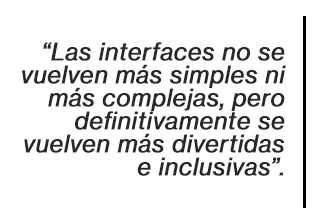 Lo explica la psicología. Nuestro cerebro está diseñado para que no le gusten los cambios, ni siquiera los buenos. Eso provoca estrés y requiere mucho trabajo cognitivo. Es difícil para nosotros acostumbrarnos a otra rutina. La navegación al usar la interfaz es también una rutina. A las personas no les importa el diseño en sí, solo quieren obtener lo que vinieron a buscar.
Lo explica la psicología. Nuestro cerebro está diseñado para que no le gusten los cambios, ni siquiera los buenos. Eso provoca estrés y requiere mucho trabajo cognitivo. Es difícil para nosotros acostumbrarnos a otra rutina. La navegación al usar la interfaz es también una rutina. A las personas no les importa el diseño en sí, solo quieren obtener lo que vinieron a buscar.
Mover el botón a un lugar más conveniente para que sea más fácil de encontrar a veces no convence al usuario. Porque está acostumbrado a que tiene que hacer 10 clicks para encontrar ese mismo botón al final de la página. Este usuario está molesto de que se hayan realizado algunas innovaciones. Hay muchos fenómenos de este tipo y fenómenos mentales que aplican a UI / UX.
¿Cuál es el procedimiento para extraer información de uso de aplicaciones por parte de los usuarios para así hacer evolucionar la propuesta?
En Filmin, como en otras empresas de tecnología, utilizamos pruebas A / B. Es una metodología de investigación de la experiencia del usuario. La prueba consta de 2 opciones de diseño: diferentes usuarios, de forma aleatoria, ven diferentes versiones. Basándonos en estadísticas, probamos nuestras hipótesis y mejoramos el producto.
También miramos a qué hora nuestros usuarios consumen Filmin más. Por ejemplo, aumenta el sábado por la noche y decae en el período de las playas. Con base en estas estadísticas, al final de cada año hacemos un resumen. Cada usuario de Filmin puede ver por sí mismo qué géneros vieron más, en qué días, cuántas horas en total pasaron viendo películas y mucho más.
El día de mañana
¿Cuál dirías que es la tendencia en el ámbito UI / UX? ¿Se tiende hacia una simplificación o se está tendiendo a añadir capas de complejidad en tanto que el usuario demanda opciones de control avanzadas?
Las tendencias en el mundo del UI / UX están sincronizadas con las tendencias generales del mundo. Cada vez, los productos digitales son más inclusivos, diversificados, transparentes y abiertos a las personas con discapacidades.
El diseño ayuda a las personas a utilizar la tecnología de forma más eficaz y tratarla como una herramienta que mejora la vida diaria. IBM Deep Blue una vez derrotó al campeón mundial de ajedrez Garri Kaspárov. Fue increíble, porque si la computadora venció a uno de los mejores jugadores del mundo, ¿cuál es el sentido de continuar jugando? Kaspárov vio una oportunidad y la siguiente vez jugó contra otra persona. En aquellas partidas, ambos jugadores usaron computadoras para aumentar sus habilidades y mejorar su juego.
Por otro lado, muchas personas en el mundo no usan los últimos modelos de teléfono, no tienen una buena conexión a Internet o no tienen Internet en absoluto. Este es el 40% de la población mundial, que todavía está offline. UI / UX debe incorporar todos estos factores y desarrollar interfaces para una audiencia más amplia.
Del mismo modo, las interfaces de voz están ganando popularidad. Pueden ser utilizadas por personas con discapacidades, personas que no saben leer o niños. Realidad aumentada, realidad virtual: todo esto son diferentes tipos de interfaces. Las interfaces no se vuelven más simples ni más complejas, pero definitivamente se vuelven más divertidas e inclusivas.
¿Qué mejoras podríamos encontrar en aplicaciones (web o móviles) como las de una plataforma como Filmin en el futuro?
Intentamos no hacer anuncios previos, pero a los usuarios de Filmin les esperan muchas cosas nuevas, interfaces mejoradas, aplicaciones mejoradas y algunas sorpresas. Somos conscientes de los problemas que existen en las aplicaciones de Filmin y estamos trabajando en ello. Muy pronto, el mundo verá un rediseño completo de aplicaciones para móviles y tablets en plataformas Android e iOS.
¿Cuáles serían las claves de tu UI / UX ideal, Julia?
Para mí, la clave de un diseño ideal no es la UI / UX en sí, sino un producto que resuelve los problemas de los usuarios a través del diseño. Por esto me encanta Filmin. Siento que nuestros usuarios lo aprecian. Durante la cuarentena, nuestro equipo recibió una carta muy agradable de un usuario que agradeció a Filmin por ayudarlo a sobrevivir a la cuarentena. ¡Yo llamo a esto un buen producto!
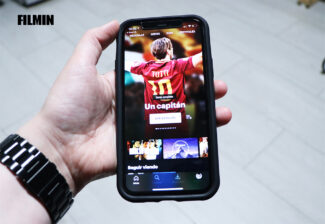 Para mí, la interfaz de usuario / UX perfecta cambiará la forma en que vivimos y trabajamos. Nos ayuda y apoya. Es un diseño que no utiliza rasgos psicológicos para manipularnos con malas intenciones.
Para mí, la interfaz de usuario / UX perfecta cambiará la forma en que vivimos y trabajamos. Nos ayuda y apoya. Es un diseño que no utiliza rasgos psicológicos para manipularnos con malas intenciones.
Uno de mis productos favoritos son los mapas de Google, que me ayudan básicamente cada día. Otros ejemplos de buen diseño de UI / UX son las pulseras bluetooth diseñadas por una empresa estadounidense para ayudar a las mujeres. Tienen botones invisibles que pueden activar una llamada al 911. Existe una herramienta online desarrollada por Artefact Studio para niños, que de manera lúdica cuenta que los algoritmos están sesgados y lo peligroso que es. Un chatbot que enseña a otras personas cómo hablar con adolescentes LGTB en crisis. El Hot Heart de Helsinki es un depósito flotante frente a la costa de la ciudad que suministrará calor a la ciudad para reducir el uso de carbón. No es perfecto, pero otro gran ejemplo de un UX/UI guay es Tesla.
An interview by Sergio Julián Gómez
Gallery
(click on any photo to start the carousel - scroll right and left by clicking on the arrow)
Did you like this article?
Subscribe to our NEWSLETTER and you won't miss anything.



